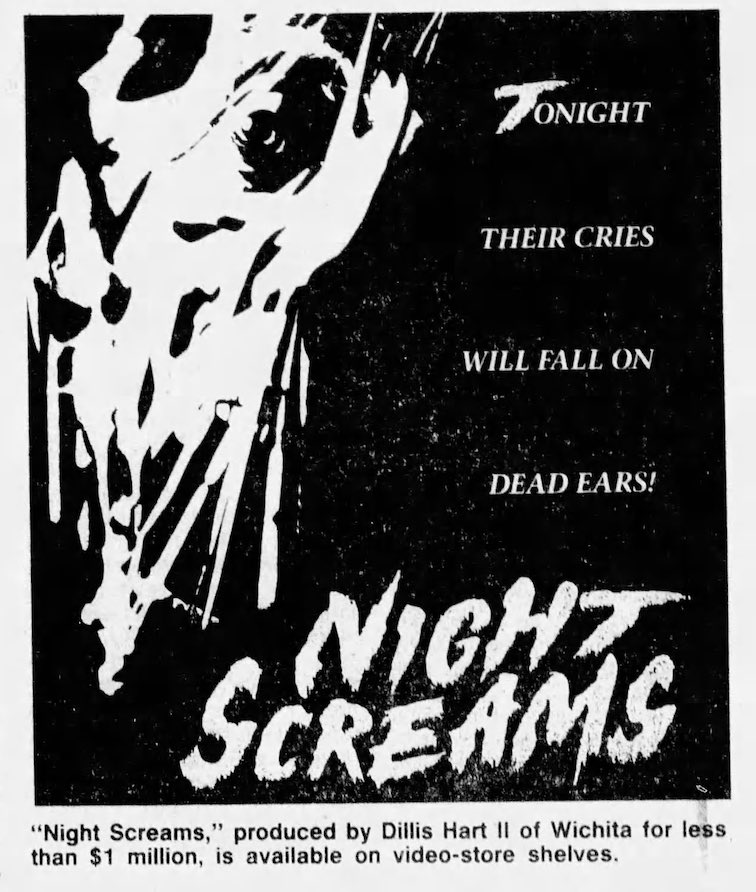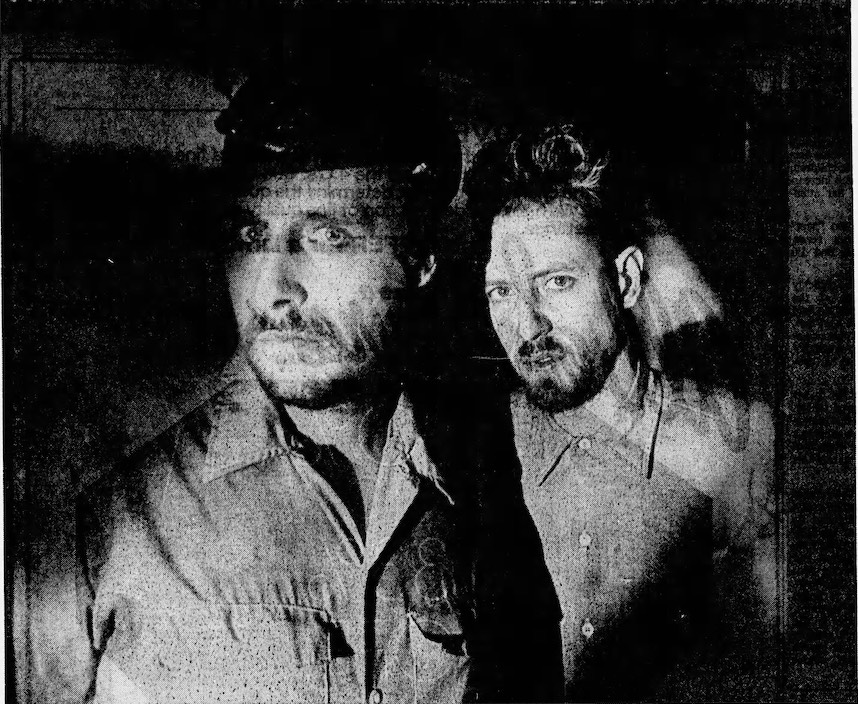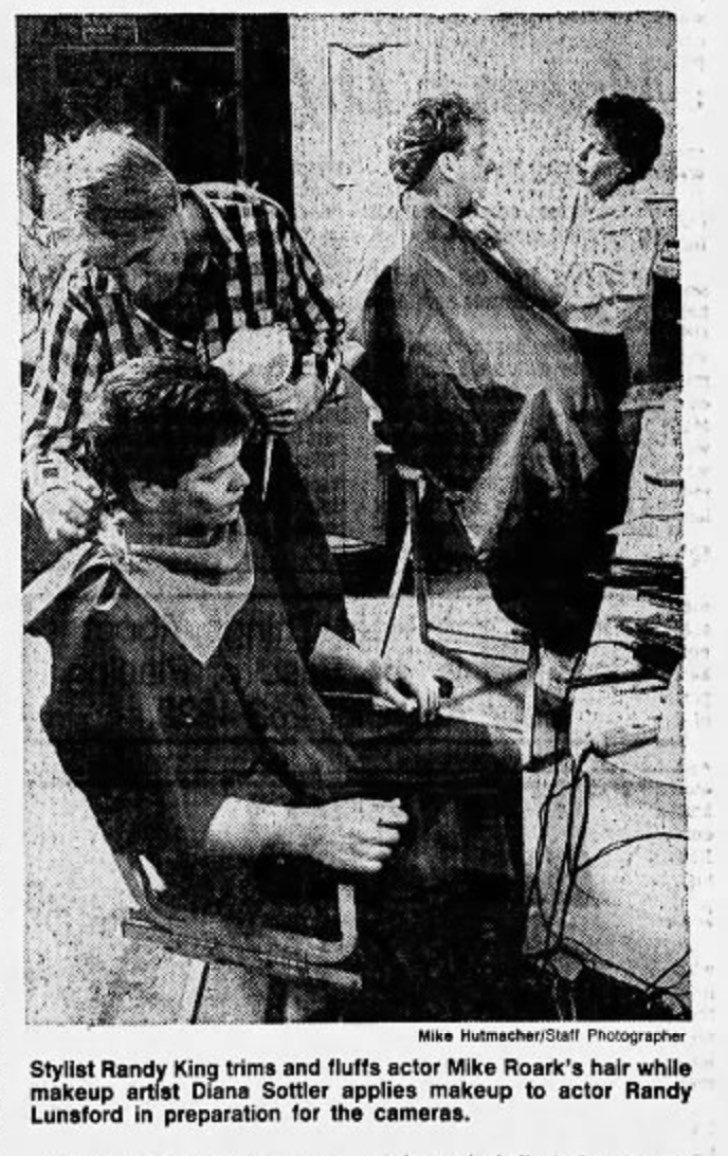THE LITTLE REGIONAL SLASHER THAT COULD: NIGHT SCREAMS by Amanda Reyes
It may not come with a shiny Hollywood price tag, but regionally shot horror has truly churned out some fantastic and classic genre fare. Pennsylvania gave us so much, such as Night of the Living Dead and The Blob. Texas of course, gave birth to Leatherface and his demented kin in The Texas Chainsaw Massacre. And, Tennessee would be ground zero for Sam Raimi’s unforgettable opus, The Evil Dead. Even if some titles don’t fall into any kind of cult infamy, there are plenty of regional horror flicks that are made with such heart that any flaws can and should be forgiven. Look at Utah’s charming, snow capped monster movie, The Boogens for a good example. Plus, Wisconsin was home base for Bill Rebane who gave us… well a bunch of Bill Rebane flicks (Giant Spider Invasion, Rana: The Legend of Shadow Lake, etc.), which is a great and wonderful thing.
 |
Regional horror has a rich and lengthy history, which is lovingly noted in Brian Albright’s Regional Horror Film, 1958-1990: A State-by-State Guide with Interviews. Albright considers regional films to be “triumphs of human determination,” and the author approaches each movie as a form of folk art. In short, he takes a serious viewpoint in a segment of the film community that is never taken seriously.
Albright points out that as technology became more accessible, filmmaking potential grew. Therefore, there was no shortage of people looking for a way into the world of film, and truly, those filmmakers may have only been armed with little more than a camera and a dream. But, there’s just something so deliciously contagious about a young and fresh crew who only want to put on a show in that old damn barn. A prime example may be that time a bunch of high school kids got everyone in Milpitas, CA involved in making a monster movie, resulting in a multi-year venture that produced the odd and fascinating B flick The Milpitas Monster. Many of these strange filmic endeavors could be quite uneven at times, but it still expresses the kind of outside-the-system passion that can be found behind all sorts of genre films. It is a fervent dedication that often can not be found anywhere else.
Somewhere along the other side of that rather hellish regional horror rainbow lies Kansas’ small but devoted horror community. That state’s best known indie production may be the excellent mindbender Carnival of Souls, but Kansas’ never-ending prairies and cornfields, as well as its drab and common midwest suburban landscapes have also served as the background for the indie 1993 cult fave, Darkness, the underrated, studio produced The Attic (1980), and the forever-charming late entry slasher Night Screams.
Night Screams may actually be the least recognized title in the bunch, which is unfortunate, because at its core, it reveals the heart of true independent filmmaking. Sure, it lays a heavy hand on some well worn slasher tropes, but it is also refreshingly unique and cleverly put together.
The opening serves as an almost meta-narrative (yes, unintentional but it is there), featuring a couple watching a slasher flick (Graduation Day) on a living room television set, while lounging on a couch. Night Screams instantly comments on the audience’s own home viewing habits, showing the act of watching as part of a cultural phenomena. The couple talk through the movie, the woman lies languidly across comfortable and well worn furniture, and her husband leaves during an important scene (the finale in fact!) to cook dinner. Night Screams cleverly draws attention to our own relationship with with these types of movies. They are, much like the hamburgers being grilled in this scene, comfort food, meant to be consumed and enjoyed but probably forgotten about by the next day.
The act of watching follows through the film. Clips from the aforementioned Graduation Day aren’t the only ones featured in Night Screams. There are also excerpts from an adult film featuring Seka. Here, we, like the characters watching the porn, become the voyeur, deriving pleasure from the act of watching not just Night Screams but the movie within that movie. It doesn’t directly break the fourth wall, but there remains an unintended but effective slant towards self-awareness; a nod to let the audience sit back because it’s only a movie, so just enjoy. It is as if the filmmakers, despite that aforementioned let’s-put-on-a-play-in-the-barn approach, are far more conscious of what they’re producing than critics perhaps originally gave them credit for. Consequently, Night Screams unwittingly comments on how we attend to, and perhaps even scrutinize and contemplate “low art” cinema: Attracted to the titillation but often half-engaged, nonetheless.
Certainly, those film clips, despite my tendency to over-analyze their purpose, are meant to work as diverting filler. And, Night Screams has many more inspired diversions to be enjoyed. The best bit of let’s-drop-in-something-that-will-kill-five-minutes moment occurs early in the film when the great, irrepressible dance troupe called The Sweetheart Dancers takes the stage at the local club. Armed with nothing more than glittery sweatshirts and appealing leotards, these ladies put on a show that is both wonderful and WTF. The game dance number serves absolutely no purpose at all, but it’s great fun, and the film would be lesser without them. Sadly the ladies disappear after their joyous number, but not before they conjure up images of the Love Boat Mermaids, if they were kicked off the ship and then became farmers who shook their moneymakers for fun. They are, in short, everything.
 |
It is actually in moments like these - the portions of the film that rely on filler to pad out its running time - that Night Screams is at its most delightful. There’s brisk locker room banter, there’s “deep” discussions about the future, there’s drunk and amusing repartee. These characters feel like they’ve been stuck in the same dead end town for their entire lives - which they have. But they are also making the most of it, and are portrayed as somewhat hopeful about the future that they think lies ahead. This makes the characters incredibly likeable, and to an extent, even real. No spoilers, but when that one character descends into the basement for a bottle of wine, never to return, it’s a little sad. I admit it.
Unfortunately, the actual story never lives up to the little filler moments. There’s an interesting twist involving more than one killer in the house, but those portions actually feel more leisurely and almost seem more like the backdrop to the rest the film than vice versa. Still, the more unique angle of the killers is a nice addition and an appreciated attempt to stand out from an already crowded room stuffed with marauders and murderers. And even in the slower bits, there’s an undeniable vibe that everyone just wants to have fun, and maybe make a film along the way. So, while Night Screams does not set out to reinvent the wheel, it is because of the novice and sincere approach by the largely unknown filmmakers and cast that there is still something refreshing to behold.
Sadly though, Variety didn’t understand, or just refused to see, the charms of Night Screams at all, stating that it was “loaded with cliches.” And, despite the film’s spirited attempt to offer something unique, the whole thing went over the head of the reviewer for the Hollywood Reporter who accused the film of being “routine.” Pshaw!
The negative reviews certainly didn’t help, and while the world of regional filmmaking could be quite lucrative despite that, Night Screams struggled for proper recognition. Without a distributor lined up, this earnest production forged ahead in April 1986. Even though it was a film that fell well outside the perimeters of Hollywood, both the Los Angeles Times and Variety mention the shoot in film production articles, which expresses the far reach that horror and home video had in the late 1980s. It was a halcyon time when mom and pop video shops longed for content, and hungry and perhaps sometimes naive filmmakers-to-be were ready to help fill those already brimming store shelves. Other genre movies that went into production around the same time as Night Screams include Ken Russell’s Gothic, The Texas Chainsaw Massacre II and Evil Dead II.
Night Screams did find some promotional opportunities at the American Film Market in 1987. Overseas Filmgroup represented it, screening clips to unsuspecting buyers. Other projects Overseas brought to AFM that year include Tales from the Darkside (the TV series), Hollywood Dream, which starred Zsa Zsa Gabor, and something called Deathflash (now titled Death Flash, although it’s mostly forgotten either way). Night Screams, an obvious slasher, was promoted as a “suspense thriller.”
 |
Prism Entertainment would become Night Screams distributor. And like the filmmakers, they share a similar blue collar attitude about how to get a film out to the public… Just do it. Although the market of home video was large and vast, Prism struggled with playing the game of big fish/little fish with the major studios during this era. In 1988 Billboard magazine reported on indie video companies sidestepping competitors by going directly to the retailer. Then-President of Prism Entertainment, Barry Collier told the trade publication, “We know we can’t demand [equal] attention on the strength of the product we offer, but we also know retailers are interested in buying our product. So even though we can’t expect distributor salespeople to carry on a 15-minute conversation on behalf of Blood Rage or Night Screams, nine out of ten customers will buy them if they’re packaged as genre horror pictures through proper selling. So we do it ourselves.”
However, even though it made it onto home video, as mentioned earlier, the slasher craze of the early eighties had largely passed, and Night Screams simply slipped into relative obscurity. It wasn’t the only slasher to show up in video stores that year, to be certain. Titles like Blood Frenzy, and Open House were just a few of the productions that were still following the basic slasher blueprint, although each one managed to inject something new into it. But, tastes were changing. The theatrical world of 1987 looked a bit different, and many of the releases were nihilistic, trading in parties, drinking and sex for more cerebral fare. There was the release of Clive Barker’s masterpiece of pleasure and pain, Hellraiser, as well as John Carpenter’s mind-bending Prince of Darkness. Audiences also flocked to slicker productions, and eagerly took a bite out of the gorgeous MTV inspired vampire comedy The Lost Boys. Other movies such as Hello Mary Lou: Prom Night II and the aforementioned Evil Dead II were glorious exercises in special effects and clever camera work. And, all of those theatrical releases are further connected by their exploration of the supernatural. Other smaller 1987 titles following in a similar vein include Dolls, My Best Friend is a Vampire, The Gate, Forever Evil, Zombie High and The Video Dead. There were even a couple of supernatural slashers released in 1987. Titles include Berserker, The Lamp (aka The Outing), Slumber Party Massacre II and the big budget thrillride Nightmare on Elm Street 3.
That’s all to say that while the pickings were wide and varied, the bigger films had mostly abandoned unstoppable (but far more human) killers stalking sex-starved teenagers. It was inevitable that Night Screams and its brethren would get lost among the shuffle.
But its tenacity has given it life over the years, mostly kept alive on websites that specialize in this type of obscure content. The reviewers and critics on those sites can sometimes be as off putting as the critics at Variety, but Night Screams has managed to withstand the negativity, and has come to enjoy a small cult reputation over the years. Fans recognize that they’ve seen it all before, but that’s OK, because they also see something else in it. They are tuned into Night Screams’ unflagging vivacious vibe. For those of us in the know, the likeable characters and the filmmakers devotion to make something entertaining, even if it’s only meant to be enjoyed in the moment, is duly noted and very much appreciated.
Amanda Reyes is a film historian/author. She is the editor of Are You in the House Alone? A TV Movie Compendium: 1964-1999 and co-host of the Made for TV Mayhem podcast.